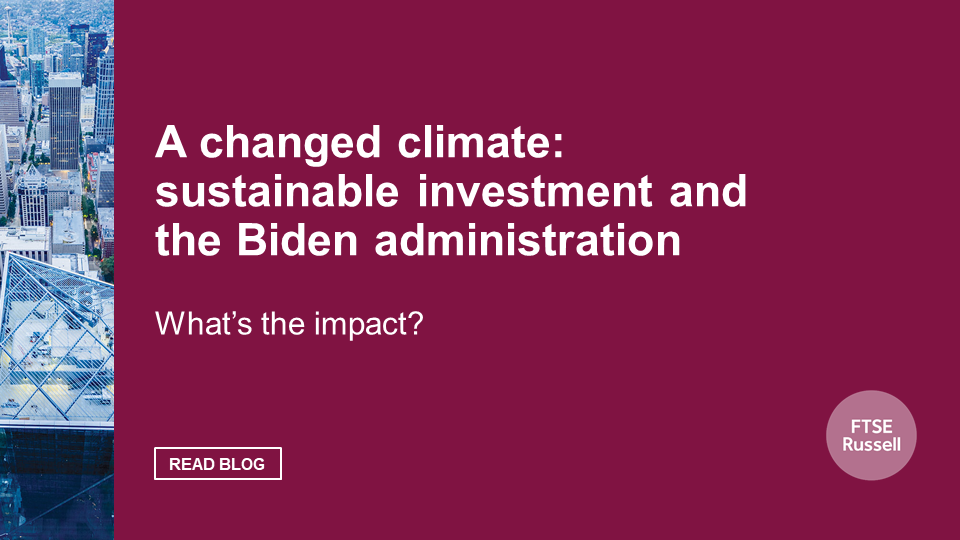A changed climate: sustainable investment and the Biden administration
How much impact could a new administration in 2021 have on sustainable investing in the US?

How much impact could a new administration in 2021 have on sustainable investing in the US?
The short answer is, quite a lot. Arguably, all four priorities of the Biden-Harris platform (COVID-19, economic recovery, racial equity and climate change) are strongly interlinked with ESG:
- Taming the pandemic can lessen both economic and social impacts
- Economic stimulus can help drive a recovery tilted towards widely available health insurance and infrastructure investments
- Such investment can support green spaces, water systems, electricity grids (carbon pollution-free power sector by 2035), clean transport and conservation work should bring tangible climate and more broadly environmental benefits
- A stronger environmental agenda brings in governance issues too, which are also part of the Economic recovery and of course Racial equity priorities
On the domestic agenda, economic recovery and the fight against COVID-19 will be key and will require a strong focus on governance, social development, diversity and fairness. On the global agenda, one of President Biden’s first pledged moves, is to re-join the 2015 Paris Agreement. This will be greatly welcomed and a clear signal to the world, but investors should also be looking for further, more concrete actions. As a growing number of countries pledge to reach net zero carbon emission by 2050 to 2060, that is now the bottom line. A tangible commitment to pursue the goals of the Paris accord would demonstrate a US return to global leadership on climate change.
Even though Democrats hold a narrow majority in the Senate, bipartisan support will be necessary to advance legislative proposals, such as concrete initiatives required to decrease US emissions. That might bring a sense of déjà vu as this occurred both under Bill Clinton then Barack Obama’s administrations over the Kyoto Protocol and Paris Agreement: they provided a Federal push and engagement at the global level, but were not able to obtain endorsement by Congress, which would have translated into significant measures to limit emissions nationwide.
Nevertheless, US lawmakers today also face a changed situation from four years ago: climate events are wreaking more havoc worldwide, including on some parts of the US, and a growing number of large corporations and investors are putting their weight behind the fight against climate change but also, and most of all, the costs of energy transition tools have now plummeted.
According to Climate Action Tracker, the 2050 net zero commitment Team Biden is proposing would allow around 0.1°C reduction of global warming by 2100. In fact, the target year for the US carbon neutrality should probably be before 2050 given the very high carbon intensity of its economy and its share in historical greenhouse gas (GHG) emissions. This long-term commitment must be translated into a 2030 target, the main indicator to be discussed during COP26.
However, Biden’s campaign promise would match recent Chinese, Japanese and Korean pledges to net-zero by 2050-2060 —which in some respects followed the EU’s impetus—and would bring the US back to the top table of global leadership on climate talks. This could mean net carbon neutral commitments for more than 50% of global carbon emissions, raising the odds for a positive outcome to COP26.
What type of actions will help the Biden-Harris administration achieve this goal?
- Clear leadership on the US climate approach working hand in hand with state-level initiatives (e.g. California’s mandates for vehicles and power generation emissions)
- Changes to prior administration’s measures on environmental regulation and federal agencies
- Marshalling the infrastructure investments and incentives needed (e.g. to decarbonize American electricity by 2035), mobilizing the deep pools of the US capital markets to accelerate the transition, fostering the broadening segments of green economy shares, green or sustainability bonds, climate focused ETFs etc.
A renewed commitment to the Paris agreement could have powerful effects on the US economy alongside its creditworthiness.
- As outlined by our American colleagues, already “the US share of the green economy stands at 37%, considerably greater than its share of global GDP, which stands at around 24%,” and one could expect that position to benefit from a Green New Deal/COVID-recovery plan
- Already some American companies, such as Tesla, are leaders in some of these fields, but others (technology companies and utilities, among others) are moving fast to leverage the falling costs and increase their share of green revenues
- Some states are leading for energy transition (e.g. California, New Mexico are leading in this space) but some, like Texas, might pivot faster towards renewables than what was already occurring
- More favorable regulatory policy in the US is possible with the new incoming leadership at several regulatory agencies such as the SEC and Department of Labor
- Last but not least, as addressed in the FTSE Climate Risk-Adjusted Government Bond Index Series, climate change is a key future risk for sovereign bonds, which is not currently priced in. A more climate-aware US may benefit from increasing investor focus on sustainability in this asset class
COP26 is less than one year from now and the likely re-engagement of the US on climate will be welcomed. However, there will be much to do in 2021 in order to achieve concrete results.
To learn more about FTSE Russell click here.
© 2021 London Stock Exchange Group plc (the “LSE Group”). All information is provided for information purposes only. Such information and data is provided “as is” without warranty of any kind. No member of the LSE Group make any claim, prediction, warranty or representation whatsoever, expressly or impliedly, either as to the accuracy, timeliness, completeness, merchantability of any information or of results to be obtained from the use of FTSE Russell products or the fitness or suitability of the FTSE Russell products for any particular purpose to which they might be put. Any representation of historical data accessible through FTSE Russell products is provided for information purposes only and is not a reliable indicator of future performance. No member of the LSE Group provide investment advice and nothing contained in this document or accessible through FTSE Russell products should be taken as constituting financial or investment advice or a financial promotion. Use and distribution of the LSE Group data requires a licence from an LSE Group company and/or their respective licensors.






